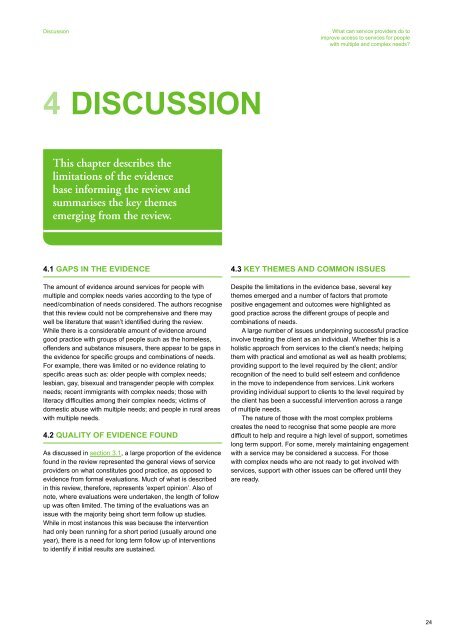What can service providers do to improve access ... - The PATH project
What can service providers do to improve access ... - The PATH project
What can service providers do to improve access ... - The PATH project
You also want an ePaper? Increase the reach of your titles
YUMPU automatically turns print PDFs into web optimized ePapers that Google loves.
Discussion <strong>What</strong> <strong>can</strong> <strong>service</strong> <strong>providers</strong> <strong>do</strong> <strong>to</strong><br />
<strong>improve</strong> <strong>access</strong> <strong>to</strong> <strong>service</strong>s for people<br />
with multiple and complex needs?<br />
4 discussion<br />
This chapter describes the<br />
limitations of the evidence<br />
base informing the review and<br />
summarises the key themes<br />
emerging from the review.<br />
4.1 gaPs in the evidence<br />
<strong>The</strong> amount of evidence around <strong>service</strong>s for people with<br />
multiple and complex needs varies according <strong>to</strong> the type of<br />
need/combination of needs considered. <strong>The</strong> authors recognise<br />
that this review could not be comprehensive and there may<br />
well be literature that wasn’t identified during the review.<br />
While there is a considerable amount of evidence around<br />
good practice with groups of people such as the homeless,<br />
offenders and substance misusers, there appear <strong>to</strong> be gaps in<br />
the evidence for specific groups and combinations of needs.<br />
For example, there was limited or no evidence relating <strong>to</strong><br />
specific areas such as: older people with complex needs;<br />
lesbian, gay, bisexual and transgender people with complex<br />
needs; recent immigrants with complex needs; those with<br />
literacy difficulties among their complex needs; victims of<br />
<strong>do</strong>mestic abuse with multiple needs; and people in rural areas<br />
with multiple needs.<br />
4.2 quaLitY of evidence found<br />
As discussed in section 3.1, a large proportion of the evidence<br />
found in the review represented the general views of <strong>service</strong><br />
<strong>providers</strong> on what constitutes good practice, as opposed <strong>to</strong><br />
evidence from formal evaluations. Much of what is described<br />
in this review, therefore, represents ‘expert opinion’. Also of<br />
note, where evaluations were undertaken, the length of follow<br />
up was often limited. <strong>The</strong> timing of the evaluations was an<br />
issue with the majority being short term follow up studies.<br />
While in most instances this was because the intervention<br />
had only been running for a short period (usually around one<br />
year), there is a need for long term follow up of interventions<br />
<strong>to</strong> identify if initial results are sustained.<br />
4.3 KeY themes and common issues<br />
Despite the limitations in the evidence base, several key<br />
themes emerged and a number of fac<strong>to</strong>rs that promote<br />
positive engagement and outcomes were highlighted as<br />
good practice across the different groups of people and<br />
combinations of needs.<br />
A large number of issues underpinning successful practice<br />
involve treating the client as an individual. Whether this is a<br />
holistic approach from <strong>service</strong>s <strong>to</strong> the client’s needs; helping<br />
them with practical and emotional as well as health problems;<br />
providing support <strong>to</strong> the level required by the client; and/or<br />
recognition of the need <strong>to</strong> build self esteem and confidence<br />
in the move <strong>to</strong> independence from <strong>service</strong>s. Link workers<br />
providing individual support <strong>to</strong> clients <strong>to</strong> the level required by<br />
the client has been a successful intervention across a range<br />
of multiple needs.<br />
<strong>The</strong> nature of those with the most complex problems<br />
creates the need <strong>to</strong> recognise that some people are more<br />
difficult <strong>to</strong> help and require a high level of support, sometimes<br />
long term support. For some, merely maintaining engagement<br />
with a <strong>service</strong> may be considered a success. For those<br />
with complex needs who are not ready <strong>to</strong> get involved with<br />
<strong>service</strong>s, support with other issues <strong>can</strong> be offered until they<br />
are ready.<br />
24


